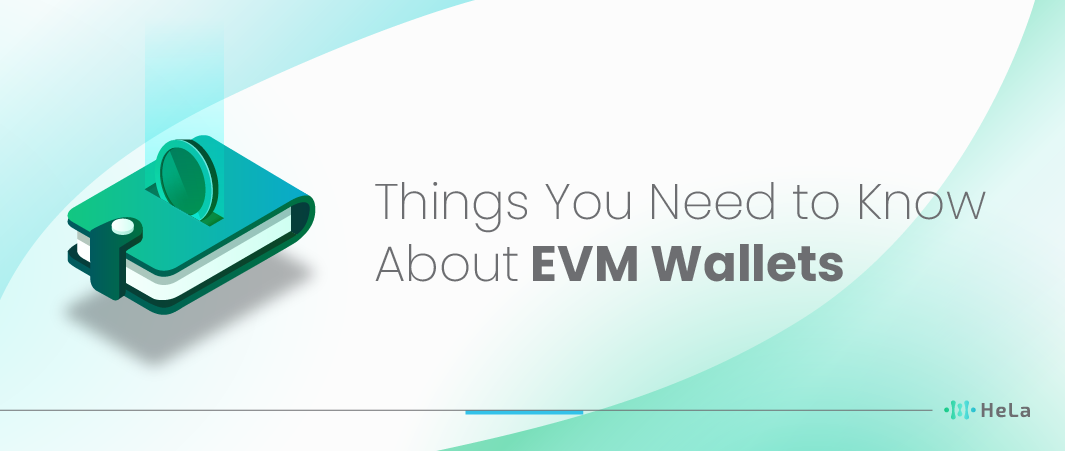Welcome to the world of blockchain and cryptocurrency, where innovations and new terms seem to pop up all the time. One such term you might have come across is the EVM Wallet, and it’s not as complex as it may sound. The Ethereum Virtual Machine (EVM) has been a game-changer, enabling decentralized applications (dApps) and smart contracts, and the EVM Wallet is a key player in this arena. In this article, we’ll demystify EVM Wallets, explaining their purpose and why they matter in our digital age.
So, what exactly is an EVM Wallet? Essentially, it’s a digital tool that allows users to interact with the Ethereum blockchain. Think of it as your gateway to the world of Ethereum, where you can send, receive, and store Ether (ETH), the native cryptocurrency of Ethereum, as well as engage with decentralized applications and smart contracts. These wallets come in various forms, from mobile apps to browser extensions and hardware devices, making it easy for anyone to access and manage their digital assets securely.
Now, you might be wondering why EVM Wallets are relevant today. Well, they empower individuals and businesses to participate in the exciting world of decentralized finance (DeFi) and NFTs (Non-Fungible Tokens), offering financial freedom and unique digital experiences. Moreover, with the ongoing developments in the blockchain space, EVM Wallets continue to evolve, providing more features, security, and user-friendly interfaces. Whether you’re a crypto enthusiast or just curious about this digital frontier, understanding EVM Wallets is a vital step in navigating the ever-expanding world of blockchain and cryptocurrency.
What is an EVM Wallet?
An EVM Wallet is like a digital Swiss army knife for cryptocurrency users. It’s a handy tool that connects you to the Ethereum blockchain and other EVM-compatible blockchains, making it super easy to manage your digital assets. Think of it as a digital wallet, but instead of holding cash or cards, it stores your cryptocurrencies and keeps your private keys safe. With an EVM Wallet, you can do things like sending, receiving, and keeping track of your digital money hassle-free.
Also Read: 6 Emerging Blockchain Layer-1 Projects in 2024
Imagine it as your virtual bank account, where you can check your balance, make payments, and even receive funds from others. EVM Wallets play a crucial role in the world of blockchain, ensuring that your crypto assets are secure and easily accessible whenever you need them. So, whether you’re new to the world of cryptocurrencies or a seasoned trader, having an EVM Wallet is a must to navigate the digital currency landscape effectively.
The Architecture of EVM Wallets

EVM (Ethereum Virtual Machine) wallets are a crucial component in the world of blockchain and cryptocurrency. These wallets are designed to interact with the Ethereum network, which is one of the most popular and widely used blockchain platforms for decentralized applications (DApps) and smart contracts. Understanding the architecture of EVM wallets involves delving into their key components and how they function within the Ethereum ecosystem.
Key Components
- Private Key: Every EVM wallet is associated with a private key, which is a cryptographic secret that allows the wallet owner to sign transactions and access their funds.
- Public Key: Derived from the private key, the public key is used to generate the wallet’s address, which is a hexadecimal string representing the destination for sending and receiving Ethereum and tokens.
- Address: This is a user-friendly representation of the public key and serves as the identifier for the wallet on the Ethereum network.
Wallet Types
- Software Wallets: These are applications or software programs that run on various devices such as smartphones, computers, or web browsers. They allow users to manage their Ethereum holdings and interact with DApps through a user-friendly interface.
- Hardware Wallets: Hardware wallets are physical devices designed to securely store the private keys offline. They are considered one of the most secure options as they are immune to online threats like hacking.
- Paper Wallets: A paper wallet involves printing out the private and public keys on a physical piece of paper. It’s a cold storage solution, meaning it’s offline and highly secure.
- Multi-Signature Wallets: These wallets require multiple private keys to authorize a transaction, providing an added layer of security and control.
Interaction with the Ethereum Network
- Blockchain Interface: EVM wallets connect to the Ethereum network through a blockchain interface. This interface allows users to query the Ethereum blockchain for information like transaction history, token balances, and smart contract interactions.
- Transaction Signing: When a user initiates a transaction (e.g., sending Ether or interacting with a DApp), the wallet uses the private key to create a digital signature. This signature is included in the transaction to verify its authenticity.
- Broadcasting Transactions: After signing a transaction, the wallet broadcasts it to the Ethereum network. Miners then validate and include the transaction in a new block if it meets the network’s criteria.
Smart Contract Interaction
- EVM wallets can also interact with smart contracts on the Ethereum network. Users can initiate transactions to invoke functions within a smart contract, such as participating in ICOs, decentralized exchanges, or other decentralized applications.
Security Considerations
- EVM wallet security is of utmost importance because any compromise of the private key can lead to a loss of funds. Users are advised to take precautions like enabling two-factor authentication (2FA), using hardware wallets, and securely storing their private keys.
Evolving Ecosystem
- The architecture of EVM wallets is continuously evolving as the Ethereum ecosystem grows. New wallet features, security enhancements, and compatibility with Ethereum upgrades, such as Ethereum 2.0 (Serenity), are continually being developed.
EVM wallets play a pivotal role in the Ethereum ecosystem, enabling users to securely store and manage their digital assets, interact with smart contracts, and participate in the decentralized applications that make Ethereum such a dynamic blockchain platform. Understanding their architecture is crucial for users to make informed choices about the type of wallet that best suits their needs and security requirements.
Also Read: Layer 1: Definition and How does it work?
The Relevance of EVM Wallets in Today’s World

In today’s rapidly evolving digital landscape, Electronic Voting Machines (EVMs) have gained significant relevance, particularly in the context of secure and convenient digital transactions and financial management. EVM wallets, also known as Electronic Wallets or E-Wallets, have emerged as a pivotal component of modern financial systems. These digital wallets enable users to store, manage, and transact various forms of currency, including cryptocurrencies, digital fiat currencies, and even loyalty points or gift cards. The relevance of EVM wallets in today’s world can be understood by examining several key factors:
Convenience and Accessibility
EVM wallets provide users with a convenient and accessible way to manage their finances. People can store their payment information securely in one place, eliminating the need to carry physical cash or multiple cards. This convenience is especially valuable in an era where digital payments have become the norm.
Digital Payment Ecosystem
EVM wallets play a vital role in the broader digital payment ecosystem. They facilitate online purchases, peer-to-peer transactions, bill payments, and even international remittances. As more businesses and individuals embrace digital payments, EVM wallets offer a versatile solution for conducting financial transactions.
Security
Security is a paramount concern in the digital age. EVM wallets incorporate robust encryption and authentication measures to protect users’ financial information. This level of security is essential to gain trust among users and ensure the safety of their funds.
Integration with Cryptocurrencies
EVM wallets often support cryptocurrencies like Bitcoin, Ethereum, and others. As cryptocurrencies gain acceptance and adoption, these wallets serve as a bridge between traditional financial systems and the world of decentralized digital currencies.
Financial Inclusion
EVM wallets have the potential to promote financial inclusion by providing access to digital financial services for individuals who may not have easy access to traditional banking. This can help empower underserved populations and boost economic growth.
Contactless Payments
The COVID-19 pandemic accelerated the adoption of contactless payments to reduce physical contact during transactions. EVM wallets, with their mobile and NFC capabilities, offer a secure and hygienic way to make payments without physical cash or cards.
Rewards and Loyalty Programs

Many EVM wallets integrate rewards and loyalty programs, allowing users to earn cashback, discounts, or loyalty points for their transactions. This incentivizes consumers to use EVM wallets for their financial transactions.
Smart Contracts and DeFi
In the realm of blockchain and decentralized finance (DeFi), EVM wallets are pivotal. They enable users to interact with smart contracts, participate in token swaps, stake cryptocurrencies, and engage in various DeFi activities.
Cross-Border Transactions
EVM wallets can facilitate cross-border transactions with reduced fees and faster settlement times compared to traditional banking systems. This is particularly beneficial for international businesses and travelers.
Potential Risks and How to Mitigate Them
EVM Wallets, or Ethereum Virtual Machine Wallets, are essential tools for managing your cryptocurrencies and assets on the Ethereum blockchain. However, like all digital tools, EVM Wallets come with their set of risks that users should be aware of. Here, we’ll delve deeper into these risks and discuss how to effectively mitigate them:
Phishing Scams
- Risk: Cybercriminals often employ phishing scams to trick users into revealing their private keys or login credentials. These scammers may create fake websites or send deceptive emails and messages to steal your valuable information.
- Mitigation: To safeguard against phishing scams, always exercise caution and follow these precautions:
- Verify Website URLs: Ensure that you’re interacting with legitimate platforms by double-checking website URLs and bookmarking trusted sources.
- Be Skeptical of Emails and Messages: Be wary of unsolicited emails or messages asking for sensitive information. Do not click on suspicious links or download files from unknown sources.
- Use Hardware Wallets: Consider using hardware wallets, which are less susceptible to phishing attacks as they store private keys offline.
Loss of Device
- Risk: Losing the device where your wallet is stored can be disastrous, especially in the case of hardware wallets, as it may lead to permanent loss of access to your assets.
- Mitigation: To mitigate the risk of losing your device and the associated consequences, follow these practices:
- Regular Backups: Create regular backups of your wallet’s private keys or seed phrases. Store these backups in secure and separate locations, such as a bank safety deposit box or a fireproof safe.
- Enable Recovery Options: Many wallet providers offer recovery options, such as mnemonic phrases or recovery seeds. Make sure to set up and securely store these options to regain access in case of device loss.
Software Vulnerabilities
- Risk: Wallet software, like any other software, may have vulnerabilities that can be exploited by malicious actors. These vulnerabilities could lead to unauthorized access or theft of your assets.
- Mitigation: To protect your assets from software vulnerabilities, take the following precautions:
- Keep Software Updated: Regularly update your wallet software to the latest version. Developers often release updates to patch known vulnerabilities and enhance security.
- Use Trusted Wallets: Choose reputable wallet providers with a track record of security and reliability. Avoid using unofficial or unverified wallet applications.
- Enable Multi-Factor Authentication (MFA): Whenever possible, enable MFA for added security. This requires an additional verification step, such as a one-time code sent to your mobile device, to access your wallet.
Future Prospects of EVM Wallets
In this dynamic blockchain ecosystem, EVM Wallets are poised for significant growth as they cater to the expanding DeFi and dApp sectors. These wallets not only ensure the secure management of digital assets but also enable seamless interaction with various blockchain platforms.
Also Read: What Is Consensus Mechanism? Relevance in Blockchain and Cryptocurrency Explained
As interoperability becomes a key focus in the blockchain space, EVM Wallets will likely evolve to support multiple chains, enhancing their versatility and importance in facilitating cross-chain transactions and asset management. As a result, EVM Wallets are likely to remain a pivotal element in the future of blockchain technology, serving as essential tools for users navigating the increasingly interconnected blockchain landscape.
Conclusion
As we journey through the vast landscape of blockchain and cryptocurrency, tools like the EVM Wallet stand out as indispensable assets. They are not just storage devices but gateways to a world of decentralized operations, smart contracts, and endless possibilities.
While the prospects are promising, it’s essential for users to stay informed and vigilant. The decentralized world offers unmatched freedom, but with freedom comes responsibility. By understanding the underlying mechanisms of EVM Wallets and the best practices for their usage, one can ensure a safe and fruitful crypto journey.
The emergence of EVM Wallets underscores the significance of user-friendly and secure interfaces in the blockchain space. As we march forward, these wallets will undoubtedly play a pivotal role in shaping the future of decentralized digital transactions.
Disclaimer: The information provided by Hela Labs in this article is intended for general informational purposes and does not reflect the company’s opinion. It is not intended as investment advice or recommendations. Readers are strongly advised to conduct their own thorough research and consult with a qualified financial advisor before making any financial decisions.

I am Carina Caringal, a technical writer specializing in blockchain engineering concepts, decentralized systems, crypto infrastructure, and Web3 technologies. My work focuses on analyzing and translating complex technical mechanisms into precise, structured, and insightful content for both developers and non-technical readers who want a deeper understanding of the decentralized ecosystem.
My background in blockchain and cryptocurrency is rooted in years of independent research, continuous learning, and hands-on exploration across multiple protocols and network architectures. I study the underlying mechanics of distributed ledger technology, from consensus algorithms and smart contract logic to network scalability, security models, cryptographic principles, and interoperability frameworks. This technical foundation shapes the way I approach every article, ensuring accuracy, depth, and relevance.
- Carina Caringalhttps://helalabs.com/blog/author/carina-caringal/
- Carina Caringalhttps://helalabs.com/blog/author/carina-caringal/
- Carina Caringalhttps://helalabs.com/blog/author/carina-caringal/
- Carina Caringalhttps://helalabs.com/blog/author/carina-caringal/

